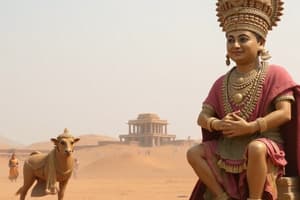Podcast
Questions and Answers
What was the primary feature of temple architecture during the Gupta period?
What was the primary feature of temple architecture during the Gupta period?
- Rectangular mandaps in front of square temples
- Panchayatana style with subsidiary shrines
- Tall, sculptured 'shikhara' roofs
- Flat roofs and monolithic structures (correct)
Which of the following was NOT a characteristic of the second stage of temple architecture?
Which of the following was NOT a characteristic of the second stage of temple architecture?
- Temples had a sculptured 'shikhara' roof (correct)
- Temples had a covered ambulatory passageway around the sanctum sanctorum
- Some temples had two storeys
- Temples were built on higher platforms
What was the key feature that distinguished the third stage of temple architecture?
What was the key feature that distinguished the third stage of temple architecture?
- Temples had a rectangular shape with an elongated mandap
- Flat roofs were replaced by low, curvilinear 'shikharas' (correct)
- Temples had a covered ambulatory passageway around the sanctum
- Temples followed the Panchayatana style with subsidiary shrines
Which of the following was a characteristic of the Panchayatana style of temple making?
Which of the following was a characteristic of the Panchayatana style of temple making?
Which of the following temple examples is mentioned in the text?
Which of the following temple examples is mentioned in the text?
What was the purpose of the covered ambulatory passageway around the sanctum sanctorum?
What was the purpose of the covered ambulatory passageway around the sanctum sanctorum?
Flashcards are hidden until you start studying
Study Notes
Temple Architecture Development
- Temple architecture developed during the Gupta period with a square sanctum and pillared portico.
- The progression of temple architecture can be divided into five stages.
First Stage
- Temples had a flat roof.
- Temples were square in shape.
- Portico was developed on shallow pillars.
- The entire structure was built on a low platform.
- Example: Temple 17 at Sanchi, Madhya Pradesh.
Second Stage
- Temples continued to have most of the features of the earlier phase.
- Platforms were higher or upraised.
- Some instances of two-storeyed temples were found.
- A covered ambulatory passageway around the sanctum sanctorum or garbhagriha was introduced.
- The passageway was used as a pradakshina path.
- Example: Parvati temple at Nachna Kuthara, Madhya Pradesh.
Third Stage
- Shikharas emerged in place of a flat roof.
- Shikharas were still quite low and almost square, i.e., curvilinear.
- Panchayatana style of temple making was introduced.
- In the Panchayatana style, there were four subsidiary shrines along with the temple of the principal deity.
- The main temple was square with an elongated mandap in front of it, giving it a rectangular shape.
Studying That Suits You
Use AI to generate personalized quizzes and flashcards to suit your learning preferences.




